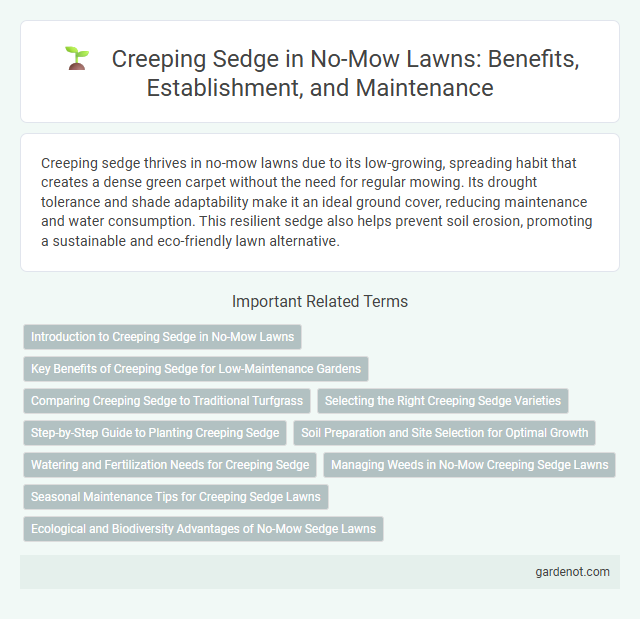Creeping sedge thrives in no-mow lawns due to its low-growing, spreading habit that creates a dense green carpet without the need for regular mowing. Its drought tolerance and shade adaptability make it an ideal ground cover, reducing maintenance and water consumption. This resilient sedge also helps prevent soil erosion, promoting a sustainable and eco-friendly lawn alternative.
Introduction to Creeping Sedge in No-Mow Lawns
Creeping sedge (Carex appressa) is a low-maintenance ground cover ideal for no-mow lawns due to its dense, mat-forming growth and tolerance to shade and drought. This perennial sedge establishes quickly, reducing soil erosion while requiring minimal water and no regular mowing, promoting sustainable lawn care. Its fine-textured foliage blends well with ornamental grasses, enhancing biodiversity and aesthetic appeal in eco-friendly landscapes.
Key Benefits of Creeping Sedge for Low-Maintenance Gardens
Creeping sedge thrives in low-maintenance gardens by providing dense ground cover that suppresses weed growth and reduces the need for frequent mowing. Its deep root system enhances soil stability and drought resistance, minimizing irrigation requirements. This evergreen plant also adapts well to various soil types and shaded areas, ensuring year-round greenery and landscape resilience.
Comparing Creeping Sedge to Traditional Turfgrass
Creeping sedge offers a drought-tolerant, low-maintenance alternative to traditional turfgrass, thriving in shaded areas and requiring minimal mowing or watering. Its dense growth pattern effectively suppresses weeds, reducing the need for chemical herbicides commonly used in conventional lawns. Unlike traditional turfgrass, Creeping sedge enhances soil health by improving aeration and moisture retention, promoting a sustainable no-mow lawn solution.
Selecting the Right Creeping Sedge Varieties
Selecting the right creeping sedge varieties involves considering factors like climate adaptability, growth habit, and maintenance requirements to ensure optimal turf performance. Popular varieties such as Carex oshimensis 'Evergold' offer low-growing, dense mats ideal for no-mow lawns, while Carex flacca provides drought tolerance and shade resistance. Choosing regionally suited types enhances durability and reduces the need for frequent mowing, making creeping sedge a sustainable alternative for no-mow lawn designs.
Step-by-Step Guide to Planting Creeping Sedge
Planting creeping sedge requires selecting a shaded or partially shaded site with well-drained soil to ensure optimal growth. Begin by preparing the soil through loosening and removing debris, then space the sedge plugs or seeds about 6 to 12 inches apart to allow for spreading. Water the area thoroughly after planting and maintain consistent moisture during the establishment period to encourage dense, low-maintenance ground cover.
Soil Preparation and Site Selection for Optimal Growth
Creeping sedge thrives in moist, well-drained soils with a slightly acidic to neutral pH between 5.5 and 7.0, making soil testing essential before planting for adjusted nutrient levels and pH balance. Select shaded to partially shaded sites with consistent moisture to ensure vigorous growth while minimizing competition from aggressive grasses. Thoroughly remove weeds and loosen the soil to enhance root establishment and water infiltration, promoting a dense, low-maintenance no-mow lawn.
Watering and Fertilization Needs for Creeping Sedge
Creeping sedge thrives in consistently moist soil conditions but requires moderate watering to prevent waterlogging, making it suitable for no-mow lawns with natural irrigation or occasional supplemental watering during dry periods. Fertilization should be minimal; applying a balanced, slow-release fertilizer once in early spring promotes healthy growth without encouraging excessive thatch buildup. This low-maintenance approach supports creeping sedge's resilience and dense ground cover in eco-friendly lawn alternatives.
Managing Weeds in No-Mow Creeping Sedge Lawns
Managing weeds in no-mow creeping sedge lawns involves regular monitoring and selective hand-weeding to maintain the dense ground cover that suppresses weed growth naturally. Applying pre-emergent herbicides specific to sedge varieties can control common invasive species without harming the creeping sedge's root system. Maintaining optimal soil moisture and fertility through organic mulches and slow-release fertilizers enhances the creeping sedge's competitiveness against weeds.
Seasonal Maintenance Tips for Creeping Sedge Lawns
Seasonal maintenance for creeping sedge lawns includes regular mowing during the growing season to a height of 1 to 1.5 inches, promoting dense growth and weed suppression. In spring, apply a balanced fertilizer with a nitrogen content around 10-10-10 to encourage healthy root development, while overseeding thin areas helps maintain uniform coverage. Fall maintenance involves reducing mowing frequency and clearing debris to prevent fungal diseases and prepare the lawn for dormancy.
Ecological and Biodiversity Advantages of No-Mow Sedge Lawns
Creeping sedge (Carex spp.) enhances no-mow lawn ecosystems by providing dense ground cover that reduces soil erosion and promotes water retention. This sedge supports biodiversity by offering habitat and nectar sources for pollinators, beneficial insects, and small wildlife. Its low maintenance and adaptability to various soil conditions make it a sustainable choice for eco-friendly landscapes.
Creeping sedge Infographic

 gardenot.com
gardenot.com